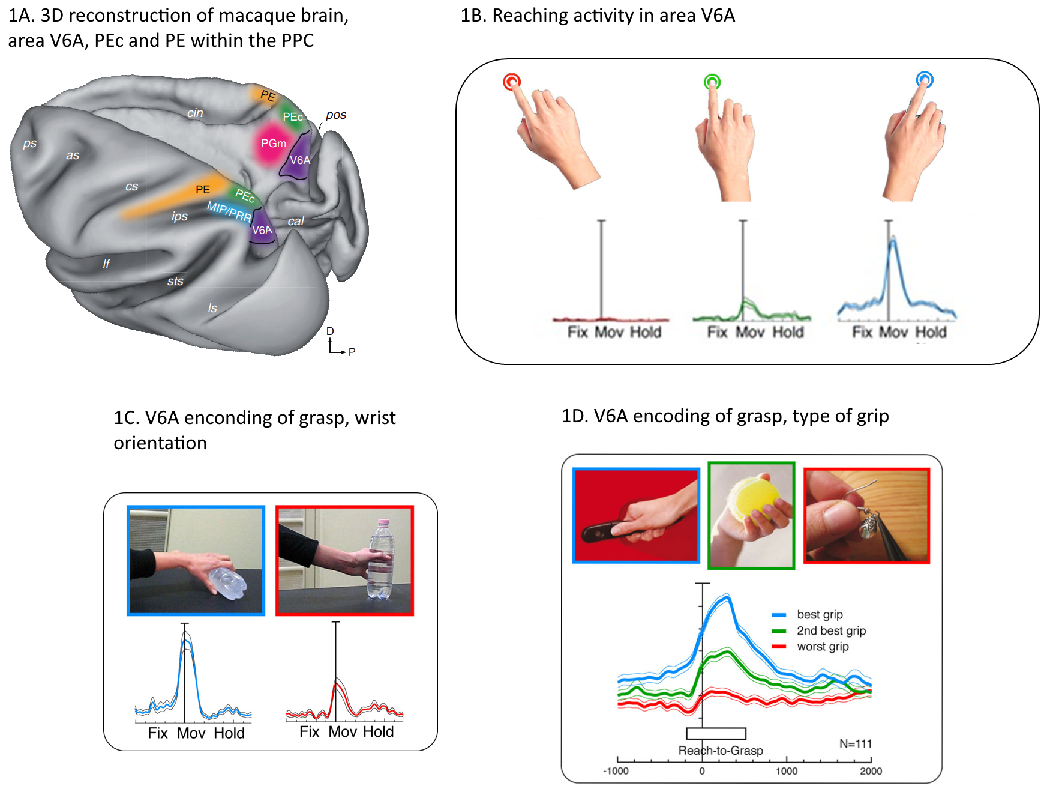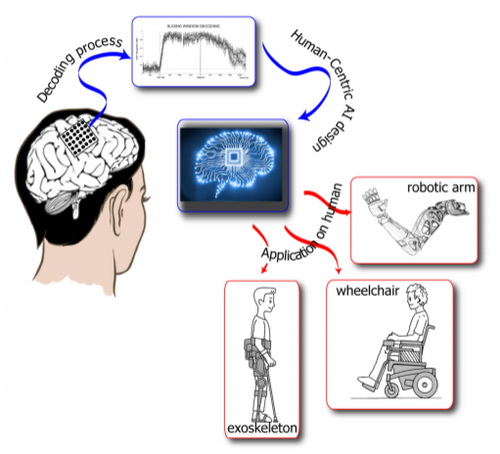- Home
- Research Interests Apri sottomenù
- Publications
- People
-
Projects
Apri sottomenù
- Progetto PNC - Fit4MedRob - Interfacce Neurorobotiche Ibride per il Controllo e il Recupero della Funzionalità Motoria e Verbale (NeuroRobCoRe)
- Progetto PNC - Fit4MedRob - Sistema innovativo per l'Analisi del Movimento e il Monitoraggio in Tempo Reale del Tremore (SMART-tremor)
- PRIN2022 - MulWalk
- Partenariato Esteso, funded by PNRR - Mnesys
- MSCA Staff Exchanges - PLACES
- PRIN 2020
- FETPROACT-2019 MAIA
- HumaneAINet
- Ricerca Finalizzata 2019 - GR-2019-12369242
- PRIN2017 - PACE
- H2020-MSCA-RISE-2016 - Platypus
- Agenda
Neurophysiology of the posterior parietal cortex
Cortical representation of reach-to-grasp actions
Accurate performance of arm movements depends on the integrity of a network of areas located in the parietal cortex, which integrate visual information about the location of objects in space with visual and somatic information about hand position, to guide arm movements. We investigate how reach-to-grasp movements are represented in the primate brain, specifically in the higher order areas of the parietal cortex (areas V6A, PEc, PE, see Fig.1A).
Using multi-electrode recordings in behaving animals, we investigate how the various movement variables (i.e. direction, distance, velocity) are specified in the ensemble activity of neuronal populations in the cortex, and how these relationships vary across the course of naturalistic movements such as reaching and grasping an object. In Fig. 1B you can see an example of the firing activity of a neuron recorded from area V6A of macaque which discharge changed depending on the direction of movement (the graph represents the cumulative discharge frequency as a function of time). In Fig.1C the neuron activity changed depending on the wrist orientation or in Fig.1D, changed according to the type of grip used to grasp different objects. The outcomes of this research are important in developing brain-machine interfaces (BMI) that will allow people with motor disabilities to control prosthetic limbs.

Gamberini M, Passarelli L, Fattori P, Galletti C. Structural connectivity and functional properties of the macaque superior parietal lobule. Brain Struct Funct. 2020 May;225(4):1349-1367. doi: 10.1007/s00429-019-01976-9. Epub 2019 Nov 11. PMID: 31712901.
Fattori P, Breveglieri R, Bosco A, Gamberini M, Galletti C. Vision for Prehension in the Medial Parietal Cortex. Cereb Cortex. 2017 Feb 1;27(2):1149-1163. doi: 10.1093/cercor/bhv302. PMID: 26656999.
Neural computations and modeling
Computational neuroscience employs mathematical tools and theories to understand what and how the brain process information and generate behaviour to perceive and interact whit the environment around us. Answer these questions is even more challenging in associative areas such as the Posterior Parietal Cortex (PPC) of macaque, extensively studied by our laboratory for its homology with the human. This region is strongly involved in visuomotor transformation and it is modulated by a plethora of different factors such as visual stimuli, somatic and proprioceptive inputs, motor efferent copies. Beyond this, the chaotic topographical organization of PPC is still unclear.
We have recently highlighted the virtual absence of units strictly selective for only one factor and revealed that most cells are characterized by ‘mixed selectivity’ within parietal visuomotor area V6A.
Diomedi S, Vaccari FE, Filippini M, Fattori P, Galletti C. Mixed Selectivity in Macaque Medial Parietal Cortex during Eye-Hand Reaching. iScience. 2020 Sep 28;23(10):101616. doi: 10.1016/j.isci.2020.101616. PMID: 33089104; PMCID: PMC7559278.

Brain Computer Interfaces and Neural Decoding
What if we could connect the brain directly to a computer?
Brain Computer Interfaces (BCIs) represent a promising approach to restore movements in patients affected by spinal cord lesions or neurodegenerative pathologies. Intact signals recorded from cerebral cortex can be decoded and used to drive neural prosthetics. Understanding how the brain codes information and how different cortical areas could contribute to prosthesis operation is still a critical point.
To drive a full capable, brain controlled, prosthetic arm, reaching and grasping components of prehension have to be accurately reconstructed from neural activity. The posterior parietal cortex (PPC) mediates sensorimotor transformations, spatial attention, and motor planning. In PPC several areas encode for different aspects of prehension acts, making the PPC an excellent source of prehension-related signals to guide neuroprosthetics.
Filippini M, Morris AP, Breveglieri R, Hadjidimitrakis K, Fattori P. Decoding of standard and non-standard visuomotor associations from parietal cortex. J Neural Eng. 2020 Aug 14;17(4):046027. doi: 10.1088/1741-2552/aba87e. PMID: 32698164.